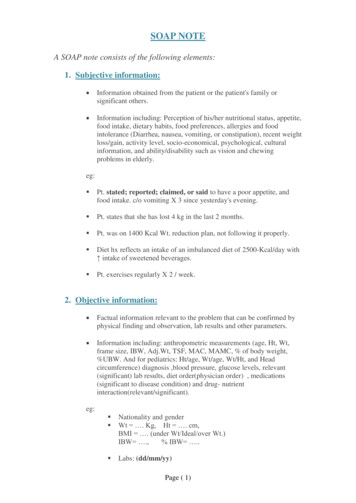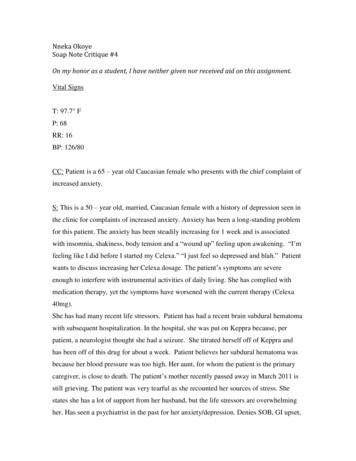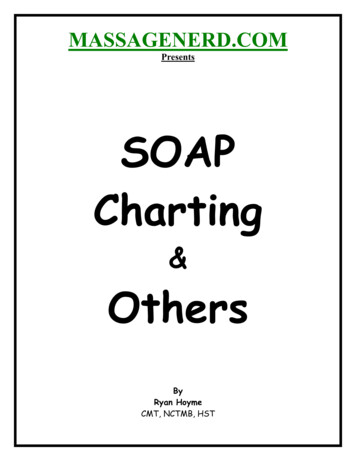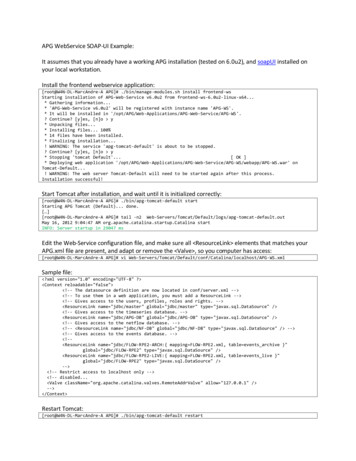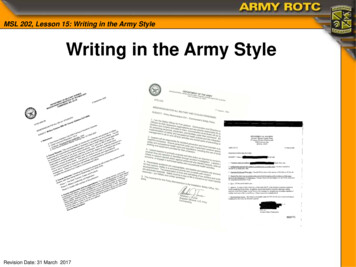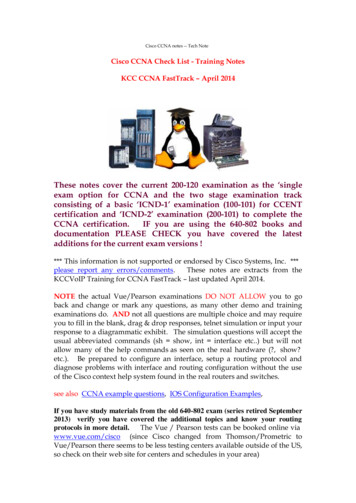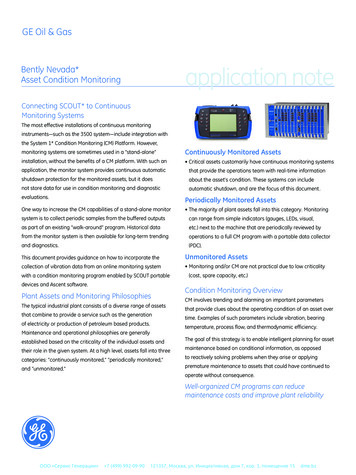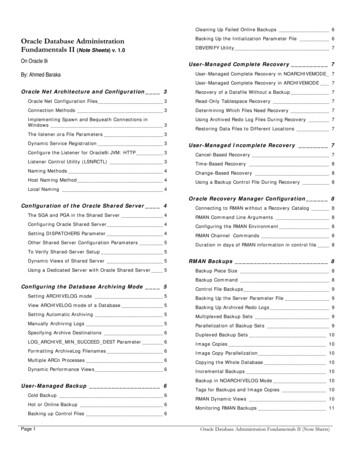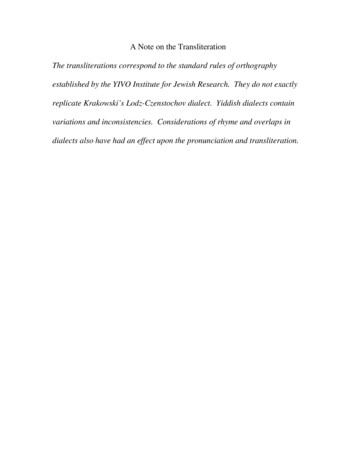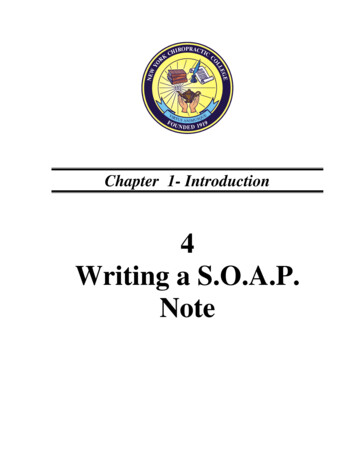
Transcription
Chapter 1- Introduction4Writing a S.O.A.P.Note
Date revised 4/23/07Writing a S.O.A.P. NoteProgress notes are the chronological record of the patient’s presentation, treatment, and responseto care, as well as a record of any telephone conversations with patients and notations on missedappointments. The system utilized to record patient progress/office visits involves notationspertaining to current subjective data, objective data, assessment, and procedures done on thatday and plans for further management (SOAP).Always keep in mind that the patient chart is a legal document, therefore you should start yournote right after the last note in the chart so it will be chronological. Cross out extra space at thebottom of a page. Also, records must be written in blue or black ink.While writing your note, do not leave blank lines in between text. This will prevent someoneelse from writing something in the blank space. Similarly, if you make a mistake, simply crossout the word with a single horizontal line, and initial it. Do not scribble out a mistake. Anyoneauditing the records must be able to see your mistakes and know that you personally crossed theword or sentence out and what was being crossed out.There should not be communication to students in the progress notes, in regards to “businessaffairs”. This should be located on a separate paper kept in the file reserved for clinician interncommunication. Notes to interns regarding patient treatment can and should be written in theprogress notes, in the “P” section.Complete sentences are not necessary and abbreviations are frequently appropriate. If nonstandard medical abbreviations are utilized, a key should be included.Initial S.O.A.P.A patient new to the facility:SOA will be part of the comprehensive exam form, and can be documented as such onProgress notes.12/18/2006 S: See compre. exam formAlthough P is on theO: See compre. exam formA: See compre.exam form – the patient responded well tocomprehensive exam form the Pthe tx, pt noted decreased px and demonstrated(management plan) could differincreased ROM in C-Spine.from what was done, PP: HMP C/T spine 10 mins, STM post c-spinemusculature B, CMT-D C-spine. Pt will return on(procedures), on initial visit. Also,12/20/06.the A on the progress note shouldstate the patient’s response to treatment. See example above.Report of findings given, Informed Consent performed.Educational and Patient Care ProtocolsChapter 1 - 41
Date revised 4/23/07For a patient not new to the clinic, but not seen in 6 months, or for an established patient with anew chief complaint. The examination or re-examination notes should be written within theprogress notes, using the S.O.A.P. format.Components of the Initial S.O.A.P. note:The following must always be included for a new chief complaint, whenever possibleanswers to questions should be quoted in patient’s own words.An additional source for SOAP and history history.htmlSubjective – the following will guide you in the taking of a pain history for a newpatient/complaint:Location- Where the patient describes the complaint is, and where the patient points tothe complaint (and what the patients utilizes such as broad hand contact, etc)Mechanism of Injury – How the symptoms started – if the patient denies trauma, (s)heshould be questioned as to new activities and repetitive activities (work and home).Onset – Date of injury (not “last Wednesday”) should be recorded as day/ month/year –If the patient cannot give a specific then “insidious onset” should be recorded with anapproximate time of initiation of symptoms such as days, weeks, months, years, ago.Palliative/Provocative - What makes it better (palliative)? What makes it worse(provocative)? May have to prompt the patient e.g. ice? Heat? Hot shower? Bending?Sleeping? Looking over shoulder to back up? Make sure to take note as to things that didnot work.Quality – Patient’s description of pain “ache” “toothache” “crampy” “ouchy” “nagging”etc.Radiation or referral– Radiating, if not “patient denies radiation or referral ofsymptoms” or “symptoms remain local”Severity – severity of sx’s “0-4” scale “0-10” scale – Pain diagram – Visual AnalogueScaleTemporal factors – Is chief complaint worse in the morning or evening? Is it constantor intermittent? Worse before or after specific activities? Getting worse since onset?Associated with mealtimes (before)? Worse seasonally? Associated with menstrualcycle?Unrelated symptoms – Associated symptoms e.g. Headaches any other “unrelated”symptoms.Various other health care providers– Seen any other healthcare providers for thiscondition, tried any other therapies, medications, chiro care before? Results? Happenedbefore? First time or (re)exacerbation?Progression of symptoms: Is the condition getting worse, better, or remain the same. Ifbetter or worse, describe.Educational and Patient Care ProtocolsChapter 1 - 42
Date revised 4/23/07Has the patient ever had the same or similar condition? Obtain past history of same orsimilar conditions. Note if this is an acute exacerbation, chronic recurrent condition, etc.– if a MVA or Work Comp Case detailed information should be attained regarding theaccident i.e. time of day it happened, where it happened, seatbelt being used, weightobject being lifted, was it reported (to supervisor or police), etc. If the complaint is of avisceral nature, then you will need to follow-up with appropriate questions outside theoutline given above.Objective:Findings from Doctor/Intern’s exam to include:o Findings from physical exam procedureso Neurological testso Orthopedic testso Inspection – of area of chief complaint, posture, gait, habitus, etc.o Palpation – of soft tissues, subluxation/intersegmental dysfunction findingso Imaging studies.o Outcomes assessments scores? (for this some say Subjective others say objectivedata)Assessment:o The current Diagnosis; the conclusion as to what the patient’s condition is, asgleaned from reviewing both subjective and objective data. The patient’s response totreatment (current day and overall) can be stated here as well. In regards todiagnosis a change in severity or stage should also be noted here e.g. a change fromacute sprain/strain to sub-acute sprain/strain.o Prognosis, Impediments to recovery? ADL limitations/Changes. Short and long termclinical/patient goals.*Medicare requires the primary diagnosis be the intersegmentaldysfunction/subluxation diagnosis code (739.X) followed by a secondary codefrom a list of diagnoses approved by Medicare for chiropractors to treat.Plan(Management)/Procedures:Management plan to include:What is going to be done for the patient; management plan to include:o Visit frequency and duration of careo Frequency and parameters of any re-evaluations to evaluate effectiveness of careo Specifics of the plan of care to include: What is going to be done, modalities, typesof STM, type(s) of CMT, stretches, exercises, home care, modifications to ADLs,referrals, nutritional advice, lifestyle modifications, etc. Also a timeline forimplementation of the aforementioned should be included if not started all at once.Educational and Patient Care ProtocolsChapter 1 - 43
Date revised 4/23/07Procedures to include:o What was done for the patient at the current visit: Report of findings given and Informed Consent performed. Modalities - time, settings, and body part applied to STM – where? Specific type? Type of CMT, Flexion Distraction, Diversified, Drop Table, Activator, etc. Home instructions – ice/heat when how long where? Stretches/ strengtheningexercises – sets, repetitions, perform after ADL’s? Perform when in pain? Alteration of ADL’s? Referrals? Next return visit, specific date, # of weeks, or p.r.n.Components of the Follow-Up S.O.A.P. note:Subjective:Response to last treatment? Changes in symptoms? New symptoms? Pain scale? Changesin ADL performance? System review, if relevant. Anything else the patient may saypertaining to his/her condition – other therapies tried, other practitioners seen.Objective:Findings from physical exam procedures, neurological tests, orthopedic tests, inspectionto include posture, gait, etc. and palpation. Imaging studies. Scores from retest onOutcomes assessment or results of parameters specified in the original Plan.Assessment:The current diagnosis; the conclusion as to what the patient’s condition is, gleaned fromreviewing both subjective and objective data. Can also state patient’s response totreatment (current and past). Impediments to recovery to include compliance, prognosis,ADL limitations/changes. Changes in short and long term patient/clinical goals.Procedures/management plan:What was done for/to the patient:o Modalities - time, settings, and body part applied toIf new complaint with an established patient, report of findings given, andInformed Consent performed as needed (new dx, modality)o Soft tissue massage – where? Specific type?o Type of Chiropractic manipulative therapy – flexion/distraction, diversified,drop, Activator, etc.o Home instructions – Use of ice or heat and when? How long? Where? Stretches/strengthening exercises – sets, repetitions, times per day, perform before or afteractivities of daily living? Perform when in pain?o Alteration of activities of daily living?Educational and Patient Care ProtocolsChapter 1 - 44
Date revised 4/23/07o Changes in treatment plan? Therapies/ modalities/ Chiropractic manipulativetherapy techniques/ referrals?o Next return visit specific date, number of weeks, or p.r.n.Documenting Medical Necessity for Medicare The P.A.R.T Documentation System*It is important to clarify in this section that we are using language to remain consistent withcurrent Medicare documents only*See NYCC protocols for subluxation algorithmMedicare requires that subluxation be documented either by x-ray or physical examination. Ifdone by physical examination, Medicare requires the use of the P.A.R.T. documentation system,which would be included in the Objective findings section of the S.O.A.P. note. Medicarerequires that at least 2 of the 4 components be documented and that at least one component of Aor R is documented.Medicare also has specific guidelines for documentation of the initial exam and follow-up visitsfor subjective information that is covered in the above guidelines for subjective information. Itshould be stated that Medicare does require that the record should document symptoms that beara direct relationship to the level of subluxation. The symptoms should refer to the spine, muscle,bone, rib and joint and should be reported as pain, inflammation, or as signs such as swelling,spasticity, etc. Medicare also requires that family and past health history, including generalhealth, prior illness, injuries, hospitalizations, medication, and surgical history be elicited fromthe patient and documented on initial examination.The Components of P.A.R.T.P - PAIN AND TENDERNESSIdentify using one or more of the following: Observation: You can document, by personal observation, the pain that the patientexhibits during the course of the examination. Note the location, quality, and severity ofthe pain. Percussion, Palpation, or Provocation: When examining the patient, ask them if pain isreproduced, such as, “Let me know if any of this causes discomfort.” Visual Analog Type Scale: The patient is asked to grade the pain on a visual analog typescale from 0 -10. Pain questionnaires: Patient questionnaires, such as the McGill pain questionnaire or anin-office patient history form, can be used for the patient to describe their pain.A - ASYMMETRY/MISALIGNMENTIdentify on a sectional or segmental level by using one or more of the following: Observation: You can observe patient posture or analyze gait. Static and Dynamic Palpation: Describe the spinal misaligned vertebrae and symmetry. Diagnostic Imaging: You can use x-ray, CAT scan and MRI to identify misalignments.Educational and Patient Care ProtocolsChapter 1 - 45
Date revised 4/23/07R - RANGE OF MOTION ABNORMALITYIdentify an increase or decrease in segmental mobility using one or more of the following: Observation: You can observe an increase or decrease in the patient’s range of motion. Motion Palpation: You can record your palpation findings, including listing(s). Be sureto record the various areas that are involved and related to the regions manipulated. Stress Diagnostic Imaging: You can x-ray the patient using bending views. Range of Motion Measuring Devices: Devices such as goniometers or inclinometers canbe used to record specific measurements.T - TISSUE, TONE CHANGESIdentify using one or more of the following: Observation: Visible changes such as signs of spasm, inflammation, swelling, rigidity,etc. Palpation: Palpated changes in the tissue, such as hypertonicity, hypotonicity, spasm,inflammation, tautness, rigidity, flaccidity, etc. can be found on palpation. Use of instrumentation: Document the instrument used and findings. Tests for Length and Strength: Document leg length, scoliosis contracture, and strengthof muscles that relate.References:American Chiropractic Association Commentary on Centers of Medicare and Medicaid Services(CMS)/PART Clinical Documentation Guidelines - www.acatoday.com/pdf/part process.pdfaccessed on 12/19/2006 at 6:30PM.ACA Clinical Documentation Committee. (2005). ACA Clinical Documentation Manual,American Chiropractic Foundation: Author.Educational and Patient Care ProtocolsChapter 1 - 46
Writing a S.O.A.P. Note Progress notes are the chronological record of the patient’s presentation, treatment, and response to care, as well as a record of any telephone conversations with patients and notations on missed appointments. The system utilized to record patient progress/office visits involves notations pertaining to current subjective data, objective data, assessment, and .
